National Treasures in Shiga 滋賀の国宝
|
|
|

Chojuji temple Hondo temple hall, National Treasure in Konan, Shiga.The hondo once burned down, but was rebuilt during the Kamakura Period.
|
|

Chojuji temple Hondo temple hall, National Treasure
|
|

Jorakuji Hondo hall, a National Treasure in Konan, Shiga. The pagoda on the left is also a National Treasure. The original temple burned down in 1360, and rebuilt the same year.
|
|

Temple roof of Jorakuji temple.
|
|

Jorakuji's Three-story pagoda is also a National Treasure Built in 1400.
|
|

Ishiyama-dera's Hondo Hall, a National Treasure. 本堂
|
|

Inside Ishiyama-dera's Hondo Hall 本堂
|
|

Finally we see Ishiyama-dera's beautiful Tahoto pagoda, a National Treasure in Otsu.
|
|

The Tahoto was built in 1194 upon the patronage of Minamoto Yoritomo. It is Japan's oldest Tahoto and one of the three most famous ones.
|
|
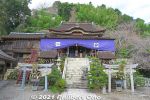
Tsukubusuma Shrine (都久夫須麻神社 National Treasure) on Chikubushima island, Nagahama, Shiga. It worships Benzaiten as well as the Dragon God and Azai-hime. Chikubushima is one of Japan's Big Three Benzaiten shrines (日本三大弁天), besi
|
|
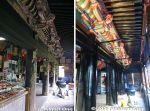
Before-and-after photos of the corridor in front of the altar. The wooden pillars that used to be covered with pilgrim name stickers are now all gone. Pillars totally re-lacquered. 観音堂
|
|
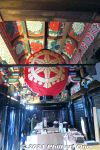
Ceiling in front of the altar includes a red paper lantern.
|
|
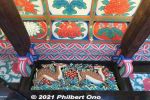
Kannon-do ceiling and transom deer carvings.
|
|

Karamon Gate 唐門 (National Treasure) before it was restored in March 2020. See the next photo.
|
|
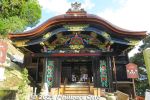
Karamon Gate looks new, but it's actually over 400 years old. "Karamon" (唐門) is a generic term for Chinese-style gates.There are other Karamon Gates in Japan, namely the more elaborate one at Nishi Hongwanji Temple in Kyoto. Karamon have colorful and intricate wood carvings and decorative features.
|
|
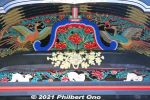
Never noticed those white rabbits before...
|
|
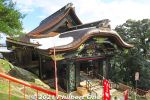
The roof was also rethatched with new cypress bark. The last time the building was reroofed was in 1972. (The white patch is snow.)
|
|

Kogenji Temple in Takatsuki, Nagahama belongs to the Buddhist Jodo Shinshu Sect (Otani school). On the left of this main hall is the Doganji Kannon Hall where the 11-face Kannon statue (National Treasure) can be viewed. 渡岸寺観音堂(向源寺)
|
|

Hikone Castle moat and cherry blossoms.
|
|
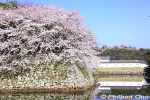
In 1606, the 1st and 2nd phases of Hikone Castle's construction were completed. The tenshu castle tower was also completed and Naokatsu moved in. This is the Castle moat and Ninomaru-Sawaguchi Tamon Yagura Turret.
|
|

Hikone Castle was built with many structures and materials transferred other Shiga castles such as Otsu Castle, Nagahama Castle, Odani Castle, Kannonji, and Sawayama Castle. This greatly reduced the cost and time required to complete the castle.
|
|

Umaya Horse Stable (Important Cultural Property).
|
|

Finally you see the main castle tower or Tenshukaku. Hikone Castle was completed in 1622 after 20 years of construction by Lord Ii Naotsugu who started building the caslte in 1603 upon his deceased father Naomasa's wish.
|
|

Hikone Castle's main tower is said to be originally the castle tower for Otsu Castle whose lord was Kyogoku Takatsugu. It was moved here in 1606. This main tower is designated as a National Treasure.
|
|

Hikone Castle is one of five main castle towers in Japan designated as a National Treasure. The others are Himeji, Matsumoto, Matsue, and Inuyama Castles.
|
|

Ceiling of Hikone Castle tower.
|
|

Headquarters of the Tendai Buddhist sect, Enryakuji is a large complex of temples, halls, buildings, and monuments on Mt. Hiei in Otsu, Shiga Prefecture. It boasts buildings which are National Treasures. MAP
|
|

Enryakuji has three temple complexes. The main and largest one is called Todo (Toto 東塔) seen on the left on this map. On the right is the Saito temple complex. The summit has a tourist attraction called Garden Museum Hiei which is not part of Enryakuj東塔, 西塔, 横川
|
|

Konpon Chudo Hall is a National Treasure and Enryakuji's main worship hall and largest building. It enshrines Yakushi Nyorai, the buddha of healing and health. 根本中堂
|
|

Kompon Chudo temple
|
|
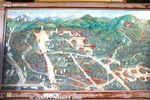
Map of Hiyoshi Taisha Shrine at the foot of Mt. Hiei. It is a complex of the so-called Seven Sanno Shrines, including two shrines designated as National Treasures. There are also 14 lesser shrines. Most things are within easy walking distance.
|
|

Hiyoshi Taisha's Nishi Hongu Honden Hall, a National Treasure. It is only one of three buildings in Japan which represent the Hie-zukuri (日吉造り) architectural style. Higashi Hongu and Usagu and the two other shrines in this style.西本宮 �
|
|

Hiyoshi Taisha's Higashi Hongu Shrine Honden, a National Treasure. This shrine worships the mountain god (Oyamakui-no-kami) of Mt. Hiei. Built in 1595. 東本宮 本殿 国宝
|
|
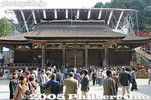
Japan's first National Treasure undergoing renovation of the roof. Saimyoji temple's Hondo hall (National Treasure) in Kora, Shiga. 本堂In 1571, Oda Nobunaga ordered Saimyoji to be burned down right after scorching Enryakuji on Mt. Hiei. Fortunately, this Kamakura-Period main hall and the pagoda survived.
|
|

Saimyoji temple Hondo Hall (National Treasure) in Kora, Shiga. In 1571, Oda Nobunaga ordered Saimyoji to be burned down right after torching Enryakuji on Mt. Hiei. Fortunately, this Kamakura-Period main hall and the pagoda survived. 本堂
|
|

Inside Saimyoji temple's Hondo hall.
|
|

Oda Nobunaga burned Saimyoji right after scorching Enryakuji on Mt. Hiei. Fortunately, the main hall and the pagoda survived. 3-story pagoda, a National Treasure
|
|

Saimyoji's 3-story pagoda, a National Treasure.
|
|

Kongorinji's main temple hall is a National Treasure housing an 11-faced Kannon statue and 13 other statues designated as Important Cultural Properties. Aisho, Shiga.
|
|

Kongorinji's Temple Hondo, a National Treasure in Aisho, Shiga.
|
|

Temple Hondo, a National Treasure
|
|

Mikami Shrine's Honden in Yasu, a National Treasure. It is a mixture of Shinto shrine and Buddhist temple architecture. It dates from the Kamakura Period, about 700 years ago. 本殿
|
|

Mikami Jinja's Honden. This was Shiga's first Shinto shrine building to be designated as a National Treasure. 本殿
|
|

Miidera temple's Kondo Hall, a National Treasure and Miidera's main worship hall built in 1599 in Otsu. 金堂
|
|
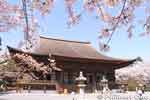
Miidera's Kondo Hall and cherry blossoms in Otsu.
|
|

Stone wall and gate to Kangaku-in Hall at Miidera temple (Onjoji), school for priests and a National Treasure but closed to the public. 勧学院
|
|

Gate to Kangaku-in Hall, school for priests at Miidera temple in Otsu. Closed to the public.
|
|

This is the closest we can get to Kangaku-in Hall, a National Treasure at Miidera temple in Otsu.
|
|

Somewhat away from the central area of Miidera is another National Treasure called Kojo-in Kyakuden. Unfortunately, it's closed to the public. All you see is this wall and a roof.
|
|

In the center is Namura Shrine's Nishi Honden hall, a National Treasure. On the left is Hachiman Shrine, an Important Cultural Property. I could finally see this building directly. Ryuo, Shiga.
|
|
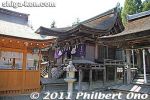
Namura Shrine's Nishi Honden hall, a National Treasure. It is dedicated to a god named Kuni-no-sazuchi-no-Mikoto (国狭槌命), the protector of grassy hills.
|
|

Osasahara Shrine's Honden Hall, a National Treasure in Yasu, Shiga. The shrine dates from the mid-Heian Period. It is dedicated to a god named Susano-o. 大笹原神社 本殿
|
|

On the left is Shinohara Shrine dedicated to Ishikoritome, the god of mochi rice cakes. The rice around here was said to be ideal for making mochi.
|
|

Osasahara Shrine's Honden Hall, a National Treasure. 大笹原神社 本殿
|
|

Zensuiji Hondo Hall in Konan, Shiga. National Treasure.
|
|
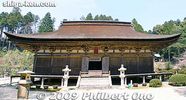
Front view of Zensuiji Hondo Hall. National Treasure. The building design is very similar to Kongorinji temple.
|
|

Zensuiji temple, National Treasure.
|
|
|
|
|
|
|